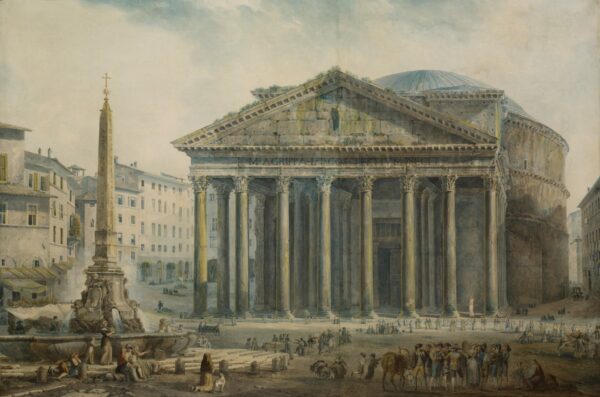View of the Pantheon, Rome
Watercolour, body colour and brown ink, partly varnished, H. 775 mm; W. 1105 mm
Verso engraving of Ducros: Avis
Label inscribed in ink: Pantheon
Branded mark on the stretcher: GHEH
Provenance: Private collection, England (early 19th century)
Dr Emil Hulmark, Sweden
Late 18th and early 19th century artists and collectors regarded Louis Ducros as one of the leading figures in landscape painting in the medium of watercolour. His work was intended to appeal to the taste of collectors who had visited Rome and Naples on the Grand Tour. They were to furnish their houses with topographical renderings of the famous Grand Toursights.
Ducros spent his formative years in Geneva and travelled to Rome in 1778. He was to complete a series of landscapes and views of ancient monuments while travelling in the employ of a Dutchman in the Kingdom of the Two Sicilies. The sketches he made provided him with an artistic vocabulary and a range of motifs that later proved invaluable. On his return to Rome he concentrated on picturesque views designed to interest foreign visitors. He published the large-format work Vues de Rome et ses Environs together with the printmaker Giovanni Volpato in 1780. The series was a runaway success. The view of the Pantheon published in the series served as a basis for the present watercolour. The only other known version is in a private collection in Geneva.
In 1784 he embarked on the large-scale watercolours which are now seen as his finest artistic achievement, no doubt encouraged by the success of his Roman prints and by the examples set by Jakob Philipp Hackert, John ‘Warwick’ Smith, Carlo Labruzzi and John Robert Cozens. He was one of the first artists to take the medium of watercolour further than tradition dictated. His drawings were heightened with body colour and touches of varnish to achieve greater effect. The dimensions demanded the use of a number of sheets which he joined together and pasted on to the canvas. The works were framed and glazed for sale. His watercolours were intended to be hung for decorative effect rather than assigned to collectors’ cabinets or portfolios. The present watercolour is a rare example of a well-preserved work still mounted on its original canvas and stretcher and in its original frame – with the artist’s own conservatorial instructions still on the verso.
Ducros’s work was widely admired by early 19th-century collectors and connoisseurs – particularly in England and Russia – and his name frequently appeared in the press. His clients included Catherine the Great, Grand Duke Paul, Sir Richard Colt Hoare of Stourhead, Sir John Acton and King Gustaf III of Sweden. In London his works sold for extraordinarily high prices: at the sale of the Cawdor Collection in June 1800 they made four times the price Lord Cawdor had paid for them on his Grand Tour fifteen years earlier.
The Pantheon is the best-preserved ancient building in Rome. Built by Emperor Hadrian in AD 118-25, it was converted into a church by Pope Boniface IV in 609. Bernini added two turrets and two monumental bronze entrance doors in 1630. Ducros’s watercolour omits – in keeping with the spirit of his times – Bernini’s Baroque additions and shows the building in its ancient guise. Piranesi had adopted the same approach in 1761. The Piazza Rotonda fountain, designed in 1578 by Giacomo della Porta, is shown in the foreground to the left. It is surmounted by an obelisk discovered in 1711 when excavations were carried out near the Church of St. Ignatius Loyola.
We are grateful to Mrs Annie Gilet for her help in cataloguing this work.
